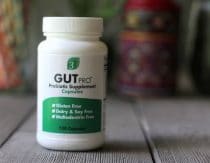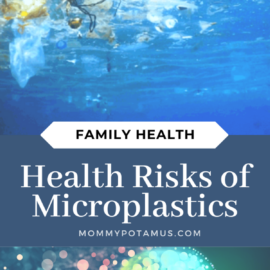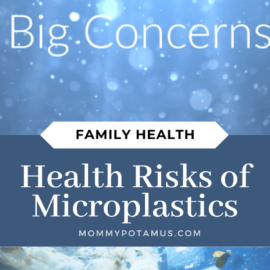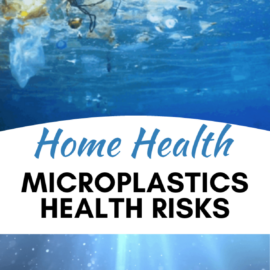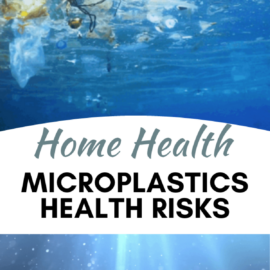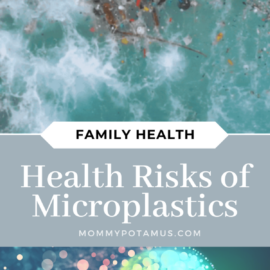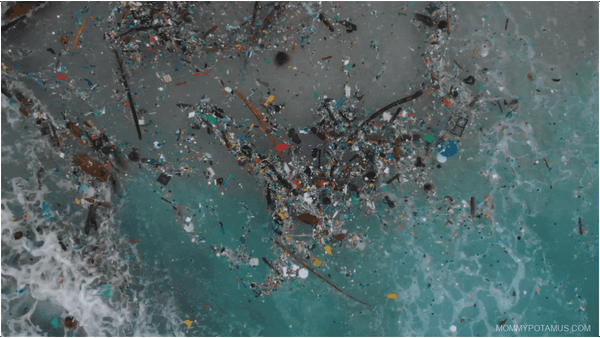
When wellness experts advise us to “eat the rainbow” for optimal health, I think we can all agree they mean fruits and vegetables . . . not brightly colored plastic particles that are small enough to infiltrate our lungs, blood, and even cells.
Unfortunately, it’s exactly those kinds of particles that have contaminated every part of our planet – they’ve been found in Arctic sea ice, the stomachs of microscopic plankton, massive humpback whales and sea creatures living in deepwater trenches.
The problem isn’t just affecting our oceans, though: microplastics have also been found in the roots of vegetables grown in our soil, beer, packaged foods, drinking water, the air in our homes, and – not surprisingly, our bodies.
In fact, if you live in the US, your tap water likely contains more microplastics than a dozen other countries tested by scientists. Yep, this study, which took water samples from a wide range of locations representing both coasts, the Midwest, Congress buildings and the US Environmental Protection Agency’s headquarters, found that 94% of samples were contaminated with microplastics. (1) Lebanon was the only other country with levels that high.
So what are the health risks of microplastics, and what can we do to reduce exposure for our families and future generations? We’ll dive into all that below, but first you might be wondering . . .
What Are Microplastics?
The tiny plastics particles collectively known as microplastics come in many shapes, sizes, and chemical combinations. Some are the result of plastic waste breaking down – for example, when discarded plastic cutlery is exposed to sunlight and other elements, they can become brittle and break into tiny jagged pieces.
Daily activities like washing clothes are a huge source of microplastic pollution, too. Synthetic clothing fibers like polyester and acrylic are made of plastic, and it’s estimated that a single load of laundry can release up to 700,000 microplastic fibers. (2)
Not all microplastics are the result of degradation or shedding, though – some are created intentionally. Microbeads, for example, are used to make personal care products like facial scrubs.
Microplastics can be the size of a grain of rice, finer than the width of a human hair, or “nanoplastic” size, which is small enough to infiltrate cells. Because of their size, microplastics can be ingested by a wide range of creatures, including us.
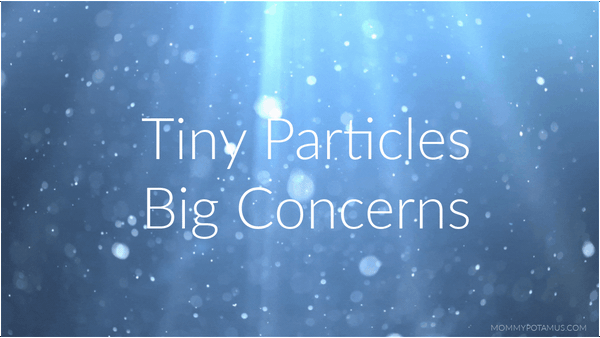
Tiny Particles, Big Concerns
The shape, size, and chemical composition of different microplastics determines how toxic they are and/or the organisms most likely to be impacted. In general, though, they cause harm in three ways:
Jagged Edges = Cellular Damage
“Most of the toxicology studies on microplastics published so far have used polystyrene beads,” which are smooth and spherical. (3)
Unfortunately, the microplastics flooding our environment are very different. According to Christie Sayes, a professor of environmental science at Baylor University, they “tend to be jagged, sharp-sided fragments with pointed edges.” (3)
Jagged edges are more likely to rupture cell walls, causing cellular death. (4) That’s just one of the concerns, though. Nanoplastics, which range between 1-100 nanometers in size – can also penetrate cells and organs, where they have the potential to cause physical and/or chemical changes. (4) More on that below.
Chemical Sponges
We all know that plastics can contain harmful chemicals like bisphenol A (BPA). They’re added during the production process to create properties like flexibility, durability, etc. However, what’s less well known is that when plastic debris is submerged in a marine environment like, say – our water supply, a nearby creek, or the ocean – they can also absorb environmental chemicals like a sponge.
Yep, we’re talking pesticides- including the now banned DDT that is still hanging around – plus heavy metals, polychlorinated biphenyls (PCB’s) and more. Unfortunately, they don’t stay locked away in a nice little bubble. Research on animals and humans shows that digestion facilitates “quite rapid release” of these toxins into our bodies. (5) (6)
Hitchhiker Pathogens
Several studies, including this one from UC Davis, have found that “by hitchhiking on microplastics, pathogens can disperse throughout the ocean, reaching places a land parasite would normally never be found.”
Yep, parasites, and also bacteria, viruses, toxic algae. (7) In addition to spreading these pathogens to ecosystems that haven’t developed defence mechanisms against them, clumps of contaminated plastics also allow colonies of bacteria to band together and share genes, including genes that increase antibiotic resistance. (8)
It’s easy for people to dismiss plastic problems as something that doesn’t matter for them, like, ‘I’m not a turtle in the ocean; I won’t choke on this thing . . . But once you start talking about disease and health, there’s more power to implement change. Microplastics can actually move germs around, and these germs end up in our water and our food.” – Karen Shapiro, infectious disease expert and associate professor in the UC Davis School of Veterinary Medicine (9)
Our soils our impacted , too – plastic particles tend to attract both fungal and opportunistic human pathogens that can significantly alter ecosystems. (10)

The Health Risks of Microplastics
When our grandparents threw plastic away, it’s not difficult to understand why they thought it would stay buried in a landfill somewhere, never to contaminate the more pristine parts of our world.
Of course we know better now, so I’m going to be upfront with you. Some of the information below might feel overwhelming, because as much as we might want to we can’t put the plastic genie back in the bottle: HOWEVER:
- Educating yourself will help you better reduce your exposure and your family’s exposure
- Now that we know better, we need do better. And we CAN do better. I’ll be discussing proactive steps you can take later in this article.
Now, let’s look at the research. Right now we have a lot of studies which look at the impacts of microplastics on animals, but only a few that relate to human health. However, according to the lead author of this meta-analysis:
Our research shows that we are ingesting microplastics at the levels consistent with harmful effects on cells, which are in many cases the initiating event for health effects . . . We know that microplastics can cross the barriers of cells and also break them, We know they can also cause oxidative stress on cells, which is the start of tissue damage.” – Evangelos Danopoulos, Hull York Medical School (11)
Also, Dr. Sherri Mason, a microplastic expert at the State University of New York, says that:
We have enough data from looking at wildlife, and the impacts that it’s having on wildlife, to be concerned . . . If it’s impacting [wildlife], then how do we think that it’s not going to somehow impact us?” (5) (6)
Here’s what we know right now:
Our Immune System Doesn’t Recognize Them (And That’s A Problem)
When we swallow something that’s not good for us – pathogenic bacteria, for example – immune cells called macrophages activate and literally eat the offender, which is then broken down via digestion and eliminated from the body.
That’s how it’s supposed to work, at least.
Unfortunately, according to researchers at the University of New Mexico, microplastics “are unlike anything the immune system has encountered over millions of years of evolution, and the macrophages have difficulty digesting them.” (12)
They try, though, and then they try some more, and they keep trying until eventually their metabolism shifts and they start releasing inflammatory molecules. (13)
That’s probably why ingesting high levels of microplastics is associated with severe inflammation and other immune system responses like allergic reactions. (14)
Research suggests they impact the immune system in other ways, too, but altering the gut microbiome and harming other human immune cells like neutrophils. (15) (16)

Microplastics Can Cross Our Blood Brain Barrier
Over a hundred years ago, a physician name Paul Ehrlich injected blue dye into the bloodstream of a mouse. All the tissues of the mouse turned blue . . . except the brain and spinal cord. That, friends, is the power of the blood brain barrier (BBB).
In optimal conditions, this semi-permeable barrier allows some things through (nutrients, for example) while keeping other things out (like circulating toxins and pathogens).
Unfortunately:
There is evidence, at least in animals, that microplastics can cross the hardy membrane protecting the brain from many foreign bodies that get into the bloodstream.”
When microplastics enter the brain they induce oxidative stress, inhibit the function of an enzyme called acetylcholinesterase, “alter neurotransmitter levels, and change behavior in several species.” 17)
They Contain “Additives of Concern”
Plastics are often manufactured with “additives of concern” such as endocrine disruptors and heavy metals like lead. (18) These additives have been linked to a wide range of health problems including cancer. (18)
Research Suggests An Increased Risk of Heart Disease
Microplastic exposure is linked to myocardial damage, fibrosis and impaired heart rate in animals. (19) (20) No studies have been done with humans yet.
Microplastics = Gut Inflammation
We know we’re ingesting microplastics because they’re found in human stool, but very few human studies have looked at their digestive effects. However, one recent study found that humans with inflammatory bowel disease (IBD) have 50% more microplastics in their stool. (21)
Right now only a correlation has been found – more research is needed to see if the higher microplastic concentrations are directly causing IBD. With that said, a significant amount of research has shown that microplastic ingestion can cause intestinal inflammation and gut microbiome dysfunction in animals. (6) (22) (23)
May Reduce Oxygen Transport
In this study, researchers found that microplastics can stretch the outer membranes of red blood cells, causing them to become deformed. It’s believed that by destabilizing the membrane of red blood cells, microplastics may limit their ability to transport oxygen. (24)
Our bodies use red blood cells to circulate oxygen to all our organs and tissues, so impairing that ability could have significant negative effects.
Reduced Fertility
According to this study, “semen quality in men has declined significantly over the last 80 years, with sperm concentration dropping to approximately one seventh of its original value. This timing coincides with the development of plastics.” They note that while other factors are also likely playing a role, research indicates that plastic pollution can impact fertility in animals and humans.
For example, in studies where mice were fed microplastics, lower exposure levels lead to reduced sperm count. At higher levels the mice had reduced sperm count, abnormal sperm and decreased testosterone. (25)
In another study done with freshwater fish, researchers found that not only did the fish who were exposed to microplastics have fewer offspring, so did their offspring who were not directly exposed. (17) In other words, the exposure had multi-generational impacts.
Can Cross The Placenta
Microplastics have been found in the placentas of pregnant women, and research suggests they’re able to pass through and reach the baby. (26)(27) Animal models support this conclusion – in this study, microparticles given to pregnant rats were transferred to the hearts, brains, and other organs of their growing babies.
We don’t yet know what the effects of microplastics on human development might be, but researchers in this study have expressed concern that they may alter key cellular regulating pathways, such as “immunity mechanisms during pregnancy, growth-factor signalling” and more, which ”may lead to adverse pregnancy outcomes including preeclampsia and fetal growth restriction.”
7 Ways To Reduce Microplastic Exposure
Every piece of plastic we find, comes from us. That means that we are the problem, which means we are also the solution.” – Dr Sherri Mason, microplastic expert at the State University of New York in Fredonia (28)
If you’re like me, you’ve probably wondered if small, consistent changes can really make much of a difference. The answer is YES.
Every year, the world collectively uses about 5 trillion single-use plastic bags. (29) Of those, the average American uses 365 single use plastic bags annually, while citizens of Denmark use four. (30)
My point is not to make us feel bad – we have all inherited a mess that we didn’t create but do need to solve. However, the good news is that making “small” but mindful changes – like investing in reusable cotton totes – can make a significant difference.
Another way to help is to support efforts to make plastics safer and more biodegradable, like this endeavor from Yale. At the moment, most compostable plastic on the market requires special processing to actually break down. It’s not really much of a solution yet, but we can let companies know that sustainability matters to us by choosing biodegradable packaging options whenever possible.
Here are some other ways to reduce your family’s exposure and the amount of plastic that flows into the environment.

1. Invest In A Good Water Filter
As I mentioned earlier, if you live in the US, your tap water likely contains more microplastics than a dozen other countries tested by scientists. Fortunately, there are water filters that can remove them. My top recommendation is a Clearly Filtered Under Sink System or Water Pitcher Filter. I have the sink system in my kitchen and I use the pitcher and/or Clearly Filtered’s water filter bottles when I travel.
In addition to removing microplastics, they also remove 232+ contaminants including heavy metals, haloacetic acids, thorium and cesium, pesticides, herbicides, phthalates, VOCs, PFAS, some pharmaceutical drugs, and fluoride.
Important Note: The under sink system keeps selling out but a small shipment just came in. If you really want a system I would order quickly because it may sell out again.
Click here and use code MP15 to save 15%
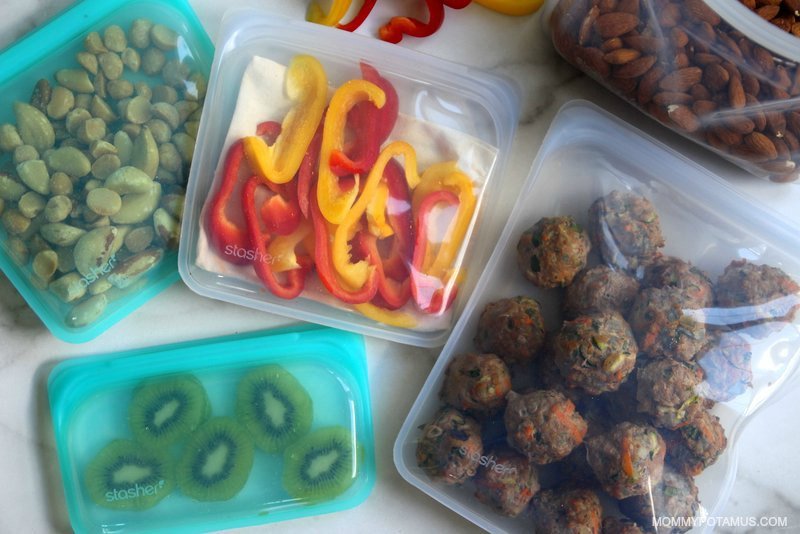
2. Avoid Single Use Plastics
- These stainless steel water bottles with built-in filters are non-toxic alternative to disposable plastic bottles. I like them more than basic reusable bottles because they can transform ordinary tap water into clean and safe drinking water by simply sipping through the straw. Over 220+ contaminants are removed.
- Organic cotton grocery totes are durable and biodegradable, unlike disposable plastic bags.
- These reusable, food-grade silicone storage bags are an excellent, durable alternative plastic baggies
3. Switch To Natural Fibers When Possible
As I mentioned earlier, it’s estimated that synthetic fibers like polyester and acrylic can release up to 700,000 microplastic fibers in a single load of laundry. (2)
When possible, opt for natural fibers like organic cotton, silk, wool, hemp or flax.
Pact Clothing is a good place to start.
4. Change Up Your Laundry Routine
Although I choose natural fibers whenever possible, some of my family’s clothing is still made with synthetic materials. We live near the ocean, so we have lots of swimsuits, swim trunks, rash guards, etc.
Recently, a few companies have started trying to reduce microplastic pollution from laundry by offering filters that can be added to the washing machine, and it sounds like dryer filters may also be in the works.
For washing machines, my top recommendation is the Cora Ball, which you just toss into the machine with your clothes. It reduces microplastic in two ways by:
- Reducing the amount of microfibers that break off into the wash, which means clothes shed less and last longer
- Catching up to 31% of the microfibers that are released
If you want to add a Cora ball to your laundry routine, click here and use code MP10 to save 10%.
5. Dust & Vacuum Regularly
We take in about 23,000 breaths every single day, mostly without thinking about it . . . and mostly indoors. Unfortunately, the air in our home is likely to be 2-5 times (sometimes up to 100 times) more polluted than the air outside. (31)
MIcroplastics are a significant contributor to indoor air pollution – for example, in one study, 39% of the dust particles in a home were actually microplastics. (32)
Fortunately, little changes can make a big difference. “We found the highest concentrations of microplastic fibres came from houses where the main floor covering was carpet, and from homes where floors were vacuumed less often,” said the author of the study. (33)
With that in mind, here are my top recommendations:
Vacuum and dust surfaces at least once a week. If possible, opt for a true HEPA vacuum which uses powerful suction to capture and retain dust particles instead of spreading them into the air. This HEPA vacuum was voted best budget pick by Prevention Magazine.
When possible, choose hard flooring over carpet. They’re usually made with synthetic fibers, plus they can act as a sponge that absorbs dust, flame retardants, dust mites, mold spores and other contaminants. (34)
If you have carpets, using a good vacuum at least once a week (ideally a HEPA) can improve indoor air quality. According to the lead author of the study:
The most significant finding was that, no matter what country we collected the dust from, the single biggest influence on the amount of microplastics in household dust was not income, or number of children, or employment – it is how often the floors were vacuumed.” (35, emphasis mine)

6. Use Air Filters That Specifically Capture Dust Particles
Since microplastics are commonly found in indoor dust, one way to reduce exposure is to invest in filters that target small particulates. HEPA filters, for example, are designed to remove “99.97% of dust, pollen, mold, bacteria, and any airborne particles with a size of 0.3 microns.” (36)
Because microplastics tend to weigh more than some other types of dust, it’s important to invest in an air purifier that has a powerful enough motor to create good air circulation. Here are my top recommendations.
7. Reduce Microplastics In Your Food
Ditch plastic food storage containers and freezer bags. These glass containers have plastic leak-proof lids, but they don’t touch the food. I also like these reusable storage bags.
Avoid plastic tea bags. One recent study found that a single plastic tea bag can release 11.6 billion microplastic particles and 3.1 nanoplastic particles at brewing temperature. (37) Even paper tea bags release a significant amount of plastic due to the polypropylene used to seal them.
Even the “plastic-free” options at your local health food store are likely to contain a plant-based form of plastic called polylactic acid, or PLA. Manufacturers will often describe it as “made out of corn starch” which is true, but it’s still plastic and there’s a lot we don’t yet know about it’s potential environmental and health impacts. I’d say it’s better than the other options, but I prefer:
- Loose leaf tea paired with a stainless steel infuser mug or glass teapot
- A truly plastic-free tea bag from a company like Traditional Medicinals, Clipper Tea, Pukka Tea, or Yogi Tea
Consider your seafood consumption. Small fish that are eaten whole (anchovies, sardines, etc.) and bivalves (clams, oysters, mussels, etc.) tend to contain more microplastics than other seafood. At the same time, anchovies and sardines contain fewer heavy metals because they’re lower in the food chain, and they’re rich in beneficial omega 3 fatty acids. Personally, I’m still eating them while making other lifestyle changes to reduce microplastic exposure.
Do you have a question about – or tip for – reducing microplastic exposure? Please leave it in the comments below!
- Orb Media (2017) Synthetic Polymer Contamination in Global Drinking Water
- University of Plymouth (2016) Washing clothes releases thousands of microplastic particles into environment, study shows
- C&EN (2022) Getting a grip on microplastics’ risks: Lessons from nanoparticle toxicology help guide path forward
- BBC (2023) How microplastics are infiltrating the food you eat
- The Guardian (2017) Plastic fibres found in tap water around the world, study reveals
- Nell Hirt and Mathilde Body-Malapel (2020) Immunotoxicity and intestinal effects of nano- and microplastics: a review of the literature
- Hakai Magazine (2022) Human Pathogens Are Hitching a Ride on Floating Plastic
- Jake Bowley et. al. (2021) Oceanic Hitchhikers – Assessing Pathogen Risks from Marine Microplastic
- UC Davis (2022) Pathogens can hitch a ride on plastic to reach the sea
- Gerasimos Gkoutselis et. al. (2021) Microplastics accumulate fungal pathogens in terrestrial ecosystems
- Medical News Today. ‘We are ingesting microplastics at levels consistent with harmful effects’
- University of New Mexico (2021) UNM Researchers Find Microplastics in Food and Water Alter the Immune System
- Seth D. Merkley et. al. (2021) Polystyrene microplastics induce an immunometabolic active state in macrophages
- Evangelos Danopoulo et. al. (2021) A rapid review and meta-regression analyses of the toxicological impacts of microplastic exposure in human cells
- Alba Tamargo et. al. (2022) PET microplastics affect human gut microbiota communities during simulated gastrointestinal digestion, first evidence of plausible polymer biodegradation during human digestion
- Wenjie Yang et. al. (2022) Impacts of microplastics on immunity
- Alexandra Martins and Lúcia Guilhermino (2018) Transgenerational effects and recovery of microplastics exposure in model populations of the freshwater cladoceran Daphnia magna Straus
- Claudia Campanale et. al. (2020) A Detailed Review Study on Potential Effects of Microplastics and Additives of Concern on Human Health
- Elisa Persiani et. al. (2023) Microplastics: A Matter of the Heart (and Vascular System)
- Jialiu Wei et. al. (2021) The impact of polystyrene microplastics on cardiomyocytes pyroptosis through NLRP3/Caspase-1 signaling pathway and oxidative stress in Wistar rats
- Zehua Yan et. al. (2022) Analysis of Microplastics in Human Feces Reveals a Correlation between Fecal Microplastics and Inflammatory Bowel Disease Status
- Rui Jia et. al. (2023) Exposure to Polypropylene Microplastics via Oral Ingestion Induces Colonic Apoptosis and Intestinal Barrier Damage through Oxidative Stress and Inflammation in Mice
- Simul Bhuyan (2022) Effects of Microplastics on Fish and in Human Health
- Saltman Quarterly (2023) Microplastics: The Blood’s Tiny yet Cruel Invaders
- Stefania D’Angelo and Rosaria Meccariello (2021) Microplastics: A Threat for Male Fertility
- Antonio Ragusa et. al. (2021) Plasticenta: First evidence of microplastics in human placenta
- Kam Sripada et. al. (2022) A Children’s Health Perspective on Nano- and Microplastics
- Clearly Filtered. Microplastics In Your Water
- United Nations Environment Program. Our Planet Is Choking On Plastic
- National Geographic (2018) Fast Facts About Plastic Pollution
- Environmental Protection Agency. Improving Indoor Air Quality
- Neda Sharifi Soltani et. al. (2021) Quantification and exposure assessment of microplastics in Australian indoor house dust
- Macquarie University (2021) ‘We are living in a sea of microplastics’: alarming new study
- Uhlig, Robert. (2001, May) Carpets are piled high with toxic pollutants
- Macquarie University (2022) Microplastics study shows Australia may be over-carpeted
- Environmental Protection Agency. What is a HEPA filter?
- Laura M. Hernandez et. al. (2019) Plastic Teabags Release Billions of Microparticles and Nanoparticles into Tea

